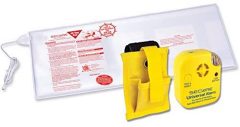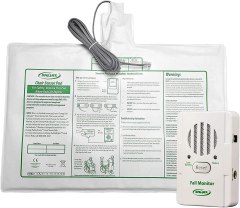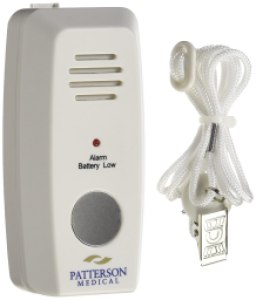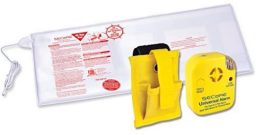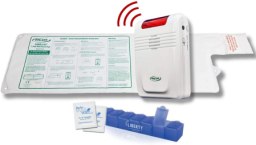Buying guide for best bed alarms
Caring for older parents or other loved ones can be a difficult, round-the-clock process. Illness, stroke, infirmity, and age-related conditions such as dementia can leave a person unsteady on their feet and susceptible to falls. A bed alarm can be an immense help, assisting in monitoring a person who may be in need of a steadying hand, in addition to providing peace of mind when you aren’t able to be at their side to provide constant supervision.
If you are in the market for a bed alarm, you’re going to want a quality product that works the way you need it to.
Key considerations
Types of bed alarms
Most bed alarms incorporate two primary elements — a sensor and a monitor — to alert you when a person is attempting to leave their bed. There are several different ways these two elements work together to achieve this goal.
Pad sensors: Pad sensors are the most common form of sensor used in bed alarms. These are flat pads that typically slide between the bottom sheet and the mattress. When a person is lying on the pad, the pressure from their body keeps the sensor from sending an alarm to the monitor. As soon as the person tries to rise from the bed, the movement or change in pressure triggers the alarm.
Pads ship in various sizes, from chair to bed size. The more surface area, the more sensor area. Any pad you select should be soft. One vital yet often overlooked element of the bed pad used in a bed alarm system is that it be comfortable to sleep on. It should also be easy to clean. The best pads are antimicrobial and waterproof in case of incontinence issues.
Motion/infrared sensors: These sensors can detect movement in a room, such as from a person leaving a bed or crossing a door threshold, and send a signal to the monitor. One additional factor here is that sensors can be incorporated into the surroundings, so the person being monitored may not even realize it.
A motion sensor should be easy to set up and position, so you can effectively supervise the areas you need to. Some monitors are capable of handling multiple sensors, enabling you to monitor several specific areas, larger areas, or even hook up a device such as a call button. One downside here is that anything breaking the sensor plane, such as a random arm or leg movement, can trigger a false alarm.
Clip sensors: These are usually in the form of a string with a clip on one end. The clip attaches to a person’s clothing, so that if they try to leave the bed, the other end of the string (typically held together by magnets) detaches, which sounds the alarm. For uncooperative patients, clip sensors may be the least effective option for a bed alarm. Clip sensors may also not be the best option for patients who suffer from delusions or paranoia (and might fear the string or clip) and those in the early to middle stages of Alzheimer’s (who can easily remove the clip without triggering the alarm).
Sensitivity
Some bed alarms, particularly pads, are so sensitive that they can be set off by the person tossing and turning in their sleep. Others require that the person physically leave the bed before the alarm sounds. Carefully consider the sleep patterns of the person and what you need the system to do before selecting a very sensitive bed alarm. A bed alarm with a built-in delay can help with this issue.
Features
Durability
Note how long any particular bed alarm is expected to last. Some manufacturers claim their products will only keep functioning for about a year. This is particularly true for some pad-based systems, which will take more abuse than clip-on or motion-based systems.
Wireless
A system that allows for wireless communication between the sensor and monitor provides a few benefits over those that don’t. One big plus of a wireless system is the lack of cords, which cuts down significantly on tripping hazards. A wireless system gives you greater freedom of movement, particularly if the monitoring side includes a remote that you can carry with you. A wireless system also keeps the alarm from startling the patient and protects them from scares or falls as a result of the loud noise. Finally, any false alarms due to sensitivity issues are far enough away that they won’t disturb the patient’s sleep.
If you choose a wireless system, know its range and how effectively the signal reaches you in various parts of your house. Doing a practice run with a wireless system before deploying it can provide you with valuable information concerning both its range and reach through walls and floors.
Volume and tones
The best bed alarms are loud enough that you can hear the alert from anywhere in the house. They also offer volume controls, so you can have the alarm trigger at various decibel levels, depending on your needs. Some bed alarms also provide the option of selecting different types of tones or chimes.
Call button
While not standard on all bed alarms, some do incorporate a call button that allows the patient to signal or talk to the caregiver.
Status lights
If a bed alarm has LED status lights, you can tell at a glance if the alarm is working. Some also include a light that indicates when the batteries are low, so you can easily keep track of when you need to change them.
Bed alarm prices
Inexpensive: You can find simple bed alarms for less than $20. These bed alarms generally have few features, and many are in the form of simple clip alarms.
Mid-range: On average, you can expect to pay around $50 to $75 for a bed alarm. As the price rises, the quality improves, and features such as wireless connectivity are more prevalent.
Expensive: Full-featured alarms cost $150 to $200 and more. At the highest prices, you can find full systems with both chair and bed capabilities, in addition to advanced features such as longer-range wireless connectivity and call buttons.
Tips
- Be careful about magnets. Sensors that use some form of magnet, like clip sensors often do, should not be used with a patient who has a pacemaker.
- Position the pad correctly. Smaller bed alarm pads can be used either under the hips (to alert you when a patient is trying to leave the bed) or under the shoulders (to alert you when the patient is trying to sit up).
- Look for a bed alarm with a built-in alarm delay. This is useful for sleepers who toss and turn frequently because the delayed alarm will return fewer false alarms.
- Check the alarm volume. A bed alarm with adjustable volume is useful in that it allows you to set the alarm to a level that’s right for you: loud enough to hear but not so loud that it scares or annoys the patient.
- Consider floor mat sensors. These can be placed next to the bed, alerting you when your loved one steps on the mat while trying to rise from the bed.
FAQ
Q. Will a bed alarm run during a power outage?
A. While some bed alarms do offer an AC option, most are powered solely with batteries, so power outages should prove to be no problem. To really protect yourself, be sure that you get a bed alarm that has a low-battery warning light, so power outages of all types won’t be an issue.
Q. Are bed alarm pads waterproof?
A. Any pad-based bed alarm that you consider should clearly state that the pad is waterproof. This is an important feature to have, particularly if incontinence is an issue.
Q. Does a bed alarm continue to sound an alert once a person has gotten out of bed, or does it only sound once?
A. This is one factor that varies depending on the model of bed alarm you get. Some of them continue to go off until you reset the alarm, either on the monitor or the sensor itself. Other bed alarms offer a minimal alert, usually in the form of one or more tones that do not repeat, requiring you to listen carefully for the tones.



